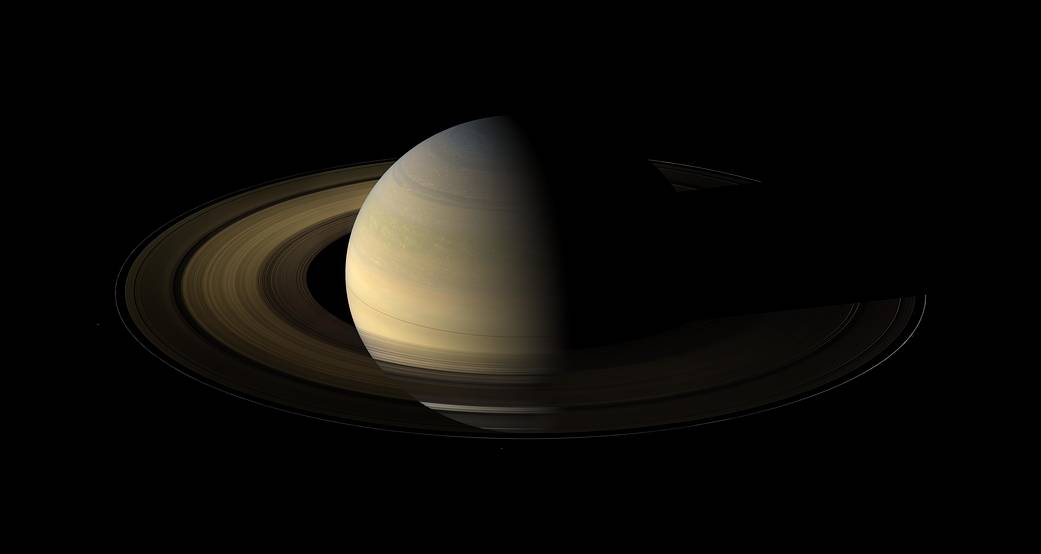Spring doesn’t just hapen on Earth. Spring also happens on some of our neighboring planets in the solar system.
Of the countless equinoxes Saturn has seen since the birth of the solar system, this one, captured here in a mosaic of light and dark, is the first witnessed up close by an emissary from Earth … none other than our faithful robotic explorer, Cassini in this image from 2009.
Seen from our planet, the view of Saturn’s rings during equinox is extremely foreshortened and limited. But in orbit around Saturn, Cassini had no such problems. From 20 degrees above the ring plane, Cassini’s wide angle camera shot 75 exposures in succession for this mosaic showing Saturn, its rings, and a few of its moons a day and a half after exact Saturn equinox, when the sun’s disk was exactly overhead at the planet’s equator.
At equinox, the shadows of the planet’s expansive rings are compressed into a single, narrow band cast onto the planet as seen in this mosaic. At this time so close to equinox, illumination of the rings by sunlight reflected off the planet vastly dominates any meager sunlight falling on the rings. Hence, the half of the rings on the left illuminated by planetshine is, before processing, much brighter than the half of the rings on the right. On the right, it is only the vertically extended parts of the rings that catch any substantial sunlight.
With no enhancement, the rings would be essentially invisible in this mosaic. To improve their visibility, the dark (right) half of the rings has been brightened relative to the brighter (left) half by a factor of three, and then the whole ring system has been brightened by a factor of 20 relative to the planet. So the dark half of the rings is 60 times brighter, and the bright half 20 times brighter, than they would have appeared if the entire system, planet included, could have been captured in a single image.
This view looks toward the northern side of the rings from about 20 degrees above the ring plane.
The images were taken on Aug. 12, 2009, beginning about 1.25 days after exact equinox, using the red, green and blue spectral filters of the wide angle camera and were combined to create this natural color view. The images were obtained at a distance of approximately 847,000 kilometers (526,000 miles) from Saturn and at a Sun-Saturn-spacecraft, or phase, angle of 74 degrees. Image scale is 50 kilometers (31 miles) per pixel.
Image Credit: NASA/JPL/Space Science Institute
春天不仅仅发生在地球上。春天也发生在太阳系的一些邻近行星上。
自太阳系诞生以来,土星经历过无数次秋分,而这一次,在这张由明暗交错组成的照片中,是地球的使者第一次近距离观察到的。这张照片拍摄于2009年,正是我们忠实的机器人探测器卡西尼号。
从我们的行星来看,春分期间土星环的视野非常狭窄和有限。但是在环绕土星的轨道上,卡西尼就没有这样的问题。在土星环平面上方20度处,卡西尼号的广角相机连续拍摄了75张土星、土星环和它的几个卫星的照片,拍摄时间是在土星春分后的一天半,当时太阳的圆盘正好在土星赤道上方。
在春分点,土星的广阔光环的阴影被压缩成一个单一的窄带投射到土星上,如图所示。此时距离春分如此之近,土星反射的太阳光所产生的光照大大超过了落在光环上的微弱阳光。因此,在处理之前,左边被土星光照亮的那一半光环比右边的那一半要亮得多。在右边,只有土星环的垂直延伸部分能捕捉到大量的阳光。
如果没有增强,土星环在这幅图片中基本上不可见。为了提高它们的可见度,土星环的黑暗部分(右)相对于明亮部分(左)被增亮了3倍,然后整个土星环系统相对于行星被增亮了20倍。因此,如果包括行星在内的整个星系都能在一张图片中捕捉到,那么土星环黑暗的那一半就会比它们看起来要亮60倍,而明亮的那一半则要亮20倍。
这张照片是从土星环平面上方约20度的角度看环的北部。
这些照片拍摄于2009年8月12日,大约在秋分后1.25天,使用了广角相机的红、绿、蓝光谱滤镜,并结合在一起创造了这幅自然色彩的景象。这些图像是在距土星约847,000公里(526,000英里)的距离以及太阳-土星航天器或相位为74度的角度下拍摄。图像尺度为每像素50公里(31英里)。
图片来源:NASA/JPL/Space Science Institute







